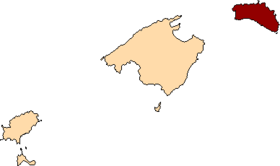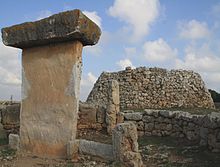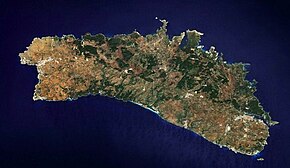Menorca
| Menorca | |||||
|---|---|---|---|---|---|
|
|||||
| location | |||||
 Balearic Islands |
|||||
| Data | |||||
| Capital | Maó | ||||
| Largest community | Ciutadella | ||||
| Official languages | Catalan , Spanish | ||||
| Population (2019) | 93,397 | ||||
| surface | 694.72 km² | ||||
| Population density | 136.6 inhabitants / km² | ||||
| Communities | 8th | ||||
Menorca [ məˈnɔɾkə ] is the easternmost and northernmost island of the Spanish autonomous region of the Balearic Islands . Its Catalan name means "the smaller one", in contrast to Mallorca , "the bigger one". 93,397 inhabitants (as of 2019) live on 694 square kilometers on Menorca. In 2006 the proportion of foreigners was 14.2% (12,543 inhabitants), the proportion of German residents was 0.8% (683). The capital is Maó.
geography
Geographical data
Menorca has an area of almost 700 km². From Cape La Mola to the headland of Bajoli , the island is about 50 kilometers long and 16 kilometers wide in a north-south direction.
The north is rocky and characterized by rugged, rugged, partly fjord-like coasts. In contrast, the south has a gentle relief with some deep gorges, the coast here is more straightforward with rocks and long sandy beaches. In the middle of the island rises the 357 meter high Monte Toro , from which one has a good panoramic view.
The approx. 285 kilometers long coastline offers the following variety: cliffs , secluded bays and long beaches as well as some natural harbors.
landscape
Outside the two cities of Ciutadella and Maó, the image of the island is mainly characterized by peaceful tranquility: many stone-walled fields, whitewashed farms with an old cheese tradition (see Mahón Menorca cheese ), idyllic villages and picturesque fishing villages.
Overall, the island is very green and forested and there is a lot of agriculture. The original north is rocky and characterized by rugged, rugged, partly fjord-like coasts, the south appears gentler, the coast is less rugged and has several beaches that can be used by tourists.
As a result of the late development by tourism, Menorca was largely saved from large hotel buildings and urban sprawl. In 1993 the island was declared a biosphere reserve. Today almost half of the island is under landscape and nature protection . Many undeveloped beaches and landscapes have thus been preserved. The construction of the tourist accommodation is more generous compared to the tourist centers of the neighboring islands (Mallorca, Ibiza). Menorca is therefore a destination for people interested in nature and culture as well as for bathing enthusiasts.
Islands
The following islands belong to Menorca and are under the administration of the Consell Insular de Menorca . On October 8, 1993, the islands were declared a biosphere reserve for the protection of typical landscapes and included in the UNESCO agreements . The focus is on the protection of individual parts of the landscape: natural monuments , protected parts of the landscape , protection of species and biotopes in accordance with Directive 79/409 / EEC on the conservation of wild birds and the fauna-flora-habitat directive for the creation of a European network of biotopes, Natura 2000 .
| Municipal area | Island name (source: CIME) |
Area (m²) |
Highest point ( msnm ) |
|---|---|---|---|
| Maó | Illa de la Quarentena also called Illa Plana | 10,000 | ... |
| Maó | Llatzaret | 293,750 | ... |
| Maó | Illa del Rei | 42,500 | 14.5 |
| Maó | de ses Àguiles | 4,475 | 23.5 |
| Maó | de sa Mesquida | ... | ... |
| Maó | Illa d'en Colom | 595,000 | 40.0 |
| Maó | Illots de sa Cúdia (two) | 12,480 | 22.7 |
| Maó | Esculler del Colomar | ... | ... |
| Maó | Escullets | ... | ... |
| Maó | de ses Àguiles | 2,500 | 13.3 |
| Maó | Gran d'Addaia | 75,500 | 22.1 |
| Maó | Petita d'Addaia | 50,000 | 7.8 |
| Ciutadella | Cala Fontanelles | 2,500 | 18.4 |
| Es Mercadal | Esculls de Cala Pregonda | 18,875 | 10.2 |
| Es Mercadal | Bleda Petita | 7,500 | 21.5 |
| Es Mercadal | de na Ponça | ... | ... |
| Es Mercadal | Escullets d'Addaia | ... | ... |
| Es Mercadal | Illa d'en Tusqueta | 6,250 | 6.1 |
| Es Mercadal | de ses Mones | 6,250 | 16.7 |
| Es Mercadal | Illa Sargantana | 25,700 | 14.5 |
| Es Mercadal | Ravells | 3.125 | 6.3 |
| Es Mercadal | dels Porros de Fornells | 1,600 | 1.4 |
| Es Mercadal | Esculls de Fornells | ... | ... |
| Es Mercadal | It Cobrombol | ... | ... |
| Es Mercadal | dels Porros also sa Nitja | 82,500 | 18.5 |
| Es Mercadal | Illetes des Carbó | 5,000 | 3.6 |
| Es Mercadal | de ses Bledes | 37,500 | 61.5 |
| Es Mercadal | Illot de Binicodrell | 5,000 | 6.1 |
| Es Mercadal | de na Joanassa | ... | ... |
| Sant Lluís | Escull de Cala Alcalfar | ... | ... |
| Sant Lluís | Illots de Binibèquer | ... | ... |
| Sant Lluís | Escull de Binissafúller | 16,250 | 3.5 |
| Sant Lluís | Esculls d'en Marçal | 3,750 | 2.5 |
| Sant Lluís | Illa de l'Aire | 343,750 | 15.0 |
Comarcas and municipalities
Menorca is divided into two comarcas , each with four municipalities:
- Comarca de Ciutadella
- Ciutadella de Menorca (Spanish: Ciudadela de Menorca )
- Es Migjorn Gran (Spanish: San Cristóbal )
- Ferreries (Spanish: Ferrerias )
- Es Mercadal
- Comarca de Mahon
- Alaior (Spanish: Alayor )
- Es Castell (formerly: Villacarlos )
- Maó (Spanish: Mahón )
- Sant Lluís (Spanish: San Luis )
climate
| Menorca (1981-2010, station Maó / Mahón airport) | ||||||||||||||||||||||||||||||||||||||||||||||||
|---|---|---|---|---|---|---|---|---|---|---|---|---|---|---|---|---|---|---|---|---|---|---|---|---|---|---|---|---|---|---|---|---|---|---|---|---|---|---|---|---|---|---|---|---|---|---|---|---|
| Climate diagram | ||||||||||||||||||||||||||||||||||||||||||||||||
| ||||||||||||||||||||||||||||||||||||||||||||||||
|
Average monthly temperatures and precipitation for Menorca (1981-2010, station Maó / Mahón airport)
|
||||||||||||||||||||||||||||||||||||||||||||||||||||||||||||||||||||||||||||||||||||||||||||||||||||||||||||||||||||||||||||||||||||||||||||||||||||||||||||||||||||||||||||||||||||||||||||||||||||||||||||||||||
prehistory

The traces of human settlement can be traced back to the Neolithic Age, i. H. up to 6000 years BC BC, trace back. The first Neolithic settlers probably came to the Balearic Islands by boat from the French Mediterranean coast. The oldest evidence of the existence of arable farmers dates from the 3rd century BC. Christ. The oldest cult building is the artificial cave , followed by the naveta , the prototalayot of the talayotic culture and the hypostylon - a room sunk about 1.5 meters into the ground with side masonry and pilasters , in the middle columns of the "western Mediterranean polylithic type", whose capitals support the ceiling panels. The island's youngest independent cult building unit is the taula , which may be an oversized hypostylon.

In 1995 and 1997, extraordinary archaeological discoveries were made in Menorca in the caves of Es Càrritx and Es Mussol in the west of the island. In Es Càrritx, the speleologists found an intact collective burial from the Late Bronze Age . The approximately 35,000 human remains, 4,000 ceramic fragments, 170 metal objects, several hundred bone buttons and faience pearls were still there as they were after the last burial around 820 BC. Had remained lying. About 90 meters from the entrance they discovered a hiding place in which wooden, metal and ceramic objects were lying, among which a number of previously unknown wooden and horn cylinders with human hair dyed red caused a sensation.
The finds from Es Mussol are similar: among other things, various wood carvings were discovered in a small chamber inside the cave, in particular two heads with clearly human features. Research into these legacies poses a particular challenge to the archaeological theory structure developed so far.
history
Menorca was influenced by many peoples: Phoenicians , Greeks , Carthaginians , Romans , Vandals , Moors , Spanish, British and French . The name of the island first mentioned was Nura - fire in Phoenician. In Roman times the island was called Minor - the smaller one, which then became Menorca.
Early Middle Ages
In 425 the Vandals under Gunderich took possession of the Balearic Islands and with them Menorca. Around 560 they came under the Eastern Roman Empire , from this to the Republic of Pisa and in 798 into the hands of the Moors and - after a Frankish interlude - then belonged to the Caliphate of Córdoba .
middle Ages
Menorca was founded in 1287 under Alfons III. recaptured by the Moors , the entire Muslim population was enslaved . Menorca now belonged just as Catalonia to Aragon Crown . At times they formed, together with parts of Catalonia, an independent state ruled by a branch line of the Aragonese royal family, the Kingdom of Mallorca . In 1344 Peter IV of Aragón conquered the Balearic Islands. Now the islands were united with the ancestral lands of the dynasty. With the union of the crowns of Aragon and Castile , they eventually became part of the Spanish monarchy.
Modern times
In 1708 Maó was conquered by the British. The Peace of Utrecht (1713), which ended the War of the Spanish Succession , gave Menorca to the British Empire. In the Seven Years' War the island was occupied by France in 1756, but was again given to Great Britain in the Peace of Paris in 1763 . After Spain and France entered the American War of Independence , Spanish-French troops conquered the island in 1782. In the Treaty of Versailles (1783) Great Britain had to formally return the island to Spain, but Menorca was again under British occupation from 1798 to 1802.
In 1833 the Spanish province of the Balearic Islands was founded. At the end of the 19th century there were the first signs of a regional independence movement. As early as 1931, in the Second Spanish Republic, an autonomous status was proposed for the Balearic Islands, but the outbreak of the Spanish Civil War prevented further decisions in this direction. Since the British kept a naval base on Menorca during the war, this protected them from an immediate seizure of power by the coup plotters . However, when the imminent defeat of the government loomed, the island was handed over to the Franquists on 7 February 1936 by Alan Hilgarth, the British consul in Mallorca, on board the HMS Devonshire . It was not until March 1, 1983 that the Statute of Autonomy for the Balearic Islands came into force.
The two largest cities on the island are:
- Maó - located at the second largest natural harbor in the world (the largest is in Sydney, Australia). The city's boom began under British rule in the 18th century. For strategic and political reasons, Maó was declared the capital in 1722 . Today Maó combines English style with a Mediterranean atmosphere.
- Ciutadella - The former island capital has retained its medieval charm to this day. In Ciutadella there is an old port, churches, aristocratic palaces and narrow, romantic old town streets, as well as opportunities for shopping and going out.
| year | 1842 | 1877 | 1900 | 1920 | 1940 | 1960 | 1981 | 2001 | 2011 |
|---|---|---|---|---|---|---|---|---|---|
| Residents | 32,118 | 33,530 | 38,373 | 42,849 | 42,180 | 42,305 | 57,243 | 71,524 | 94,875 |
language
The official languages are Catalan and Spanish (Castilian). The spoken on the island Catalan dialect is Menorquí called. Catalan has been an official language with equal rights since 1983. The Catalan language spread as a result of the conquest of Menorca by Alfonso III. in 1287 through the repopulation of the island with settlers who came mainly from Catalonia.
However, numerous words and expressions from the British occupation were also adopted into Menorcan. The word xoc example, refers to the chalk (English chalk ), mèrvels (English marbles = marble) or bòtil (English bottle = bottle) were derived.
In 1986 the Law on the Linguistic Normalization of the Catalan Language came into force, with the task of promoting the Catalan language to the public. As a result, Catalan has become more solid. On the signs on the island of Menorca you can find Catalan names such as: port (instead of puerto for port), platja (instead of playa for beach), or camí (instead of camino for the way).
Economy and Infrastructure
transport
Menorca International Airport is located in the east of the island, just under four kilometers southwest of the capital Maó (Mahon).
The port of Maó is, after the port of Sydney , the second largest natural port in the world with daily ferry connections to Barcelona , Palma and Valencia . From the port in Ciutadella there is a connection to Alcúdia in Mallorca .
power supply
The island government supports conferences and start-ups on environmentally friendly energy generation and sustainable water management.
beaches
Similar to Mallorca , Menorca has a large number of beaches and bathing bays. With regard to the nature of the beaches, the north coast (more dark and grainy), which is more popular with surfers because of the wind, and the south coast (light and fine sand), which is more popular with beach holidaymakers, differ from each other.
Menorcan cuisine
Overview
The Menorcan cuisine is simpler and more hearty than the Mallorcan. In addition to olive oil, there is also a lot of cooking with butter and cream. The mayonnaise sauce , precursors of mayonnaise is an important supplement.
The Caldereta de Langosta , which is based on lobster, is famous among gourmets . It is a fish broth similar to bouillabaisse . The lobster, in this case the species Palinurus elephas common in the Mediterranean , is the basis of the caldereta , which is offered in most restaurants that specialize in fish cuisine.
The specialty of Menorca
A particular specialty is the island's cheese, called Queso Mahón . It is made from raw cow's milk and has the “ Denominación de Origen ” seal of quality . This is strictly checked. Different maturity levels are offered. There are many cheese factories in Alaior ; The Spanish ice cream brand La Menorquina was founded there.
Personalities
- Marc Martí Totxo (1531–1617), theologian
- Richard O'Cahan (1666–1736) Governor
- Francesc de Borja Moll i Casasnovas (1903–1991), linguist, philologist
- Josep Miquel Vidal i Hernández (1939–2013), physicist, researcher and author
- José Roberto Torrent Prats (1904–1990), painter
- Chloe Morris (* 1985), Spanish dressage rider
See also
literature
- P. Castro, V. Lull, R. Micó .: Cronología de la prehistoria reciente de la peninsula Ibérica y Baleares (c. 2800-900).
- Jürgen E. Walkowitz: The megalithic syndrome. European cult sites of the Stone Age (= contributions to the prehistory and early history of Central Europe. Vol. 36). Beier & Beran, Langenweißbach 2003, ISBN 3-930036-70-3 .
- Christoth Friedrich Heinrich Lindemann: Descripció geogràfica i estadística de l'illa de Menorca , (1786), 2002, ISBN 84-95718-04-9
- José María Garrut Romá: TORRENT, Maestros actuales de la pintura y escultura catalanas (48.pg.) (1981)
- José María Garrut Romá: TORRENT, La gran enciclopedia Vasca (48.pg.) (1981)
Web links
- Information about Menorca on the official website for tourism in Spain (German)
- Consell Insular de Menorca (multilingual, also German)
Individual evidence
- ^ Institut Balear d 'Estadística
- ↑ Illes Balears: Población por municipios y sexo. www.ine.es, January 1, 2011, archived from the original on November 14, 2012 ; Retrieved November 3, 2012 (Spanish).
- ^ Charles Arnold (ed.): The islands of the Mediterranean . A unique and complete overview. 2nd Edition. Mare Buchverlag, Hamburg 2008, ISBN 978-3-86648-096-4 , p. 89 .
- ↑ Consell Insular de Menorca
- ↑ Richard Fletcher, An Elephant for Charlemagne. Christians and Muslims in the Middle Ages , Scientific Book Society, Darmstadt 2005, p. 123
- ^ Antony Beevor (traduit par Jean-François Sené): La Guerre d'Espagne . 3. Edition. No. 31153 . Éditions Calmann-Lévy, Paris 2011, ISBN 978-2-253-12092-6 , pp. 683, 829 (quoted there from Manuel Tuñón de Lara: Historia de España, Vol. IX, p. 506).
- ↑ Thomas Urban , Scout Camp for Inventors , sz.de, July 12, 2019.
Coordinates: 39 ° 58 ' N , 4 ° 5' E












